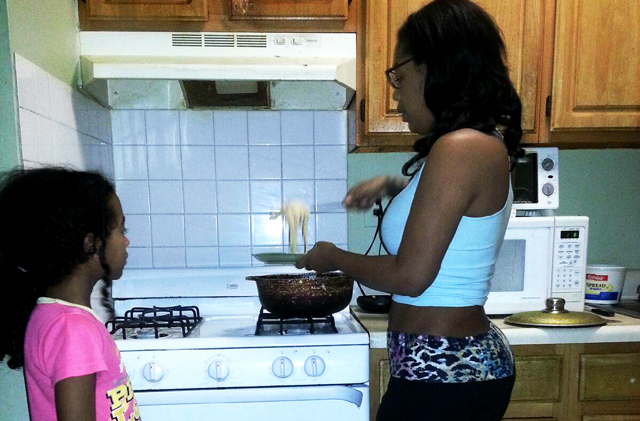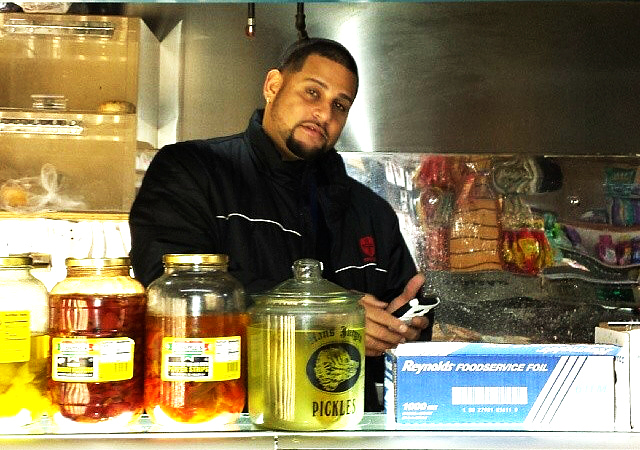Jenny Cespedes cooking for her daughter Romani Cespedes after she had received a food voucher.
By Kimberly Bedoya
With additional reporting by Michael Brown
On November 1, some 47 million Americans who are struggling to buy food were handed a setback when the federal government automatically began its cuts of nearly $5 billion of SNAP benefits. SNAP, which stands for the Supplemental Nutrition Assistance Program, is the country’s primary food stamp provider for those who are struggling right at or below the poverty line. The anti-hunger program has seen its enrollment doubled since 2004.
Cuts to SNAP have Bronxites scrambling to make up the difference to feed their families. Some are turning to local food pantries when their food runs out. “I’ve been hugely affected by this decrease in my benefits,” says Jenny Cespedes, 32, a Bronx native and a mother of two. “I am the head of the household, a single mother and I work very long hours, but my money is still not sufficient to feed my kids.”

The reduction in benefits has affected millions like Cespedes. It is one of the largest cuts in the program since Congress first initiated the Food Stamp Act in 1964. According the SNAP county-by-county review, 27 percent of Bronx residents, or 405,492 people, receive food stamps.
The food stamp cut has made the role of pantries and food banks more critical this year. “POTS,” which stands for Part of the Solution, allows residents to shop for groceries, including fresh produce and dairy items, once a month. Each visit to the pantry provides enough food to feed a household for three days. POTS also has a community dining room, where it provides healthy meals to the homeless, poor and working low income Bronxites.
Prior to Thanksgiving Day, dozens of people stood in front of POTS on Webster Avenue waiting to receive a turkey and other items. “It was quite heartbreaking,” said Daisy Quinones, 27, a volunteer at POTS. “You see mothers with their children, freezing online, waiting for some type of help. The cut came in such bad timing, right before the holidays.”

The New York Yankees and food wholesaler White Rose handed out 1,200 supermarket vouchers worth $25 on November 17. Those that received one were grateful for the extra cash. “It’s really a blessing to have received this voucher,” said Gabriela Mendez 67, who is unemployed. “I really needed it. We all need a helping hand during the holidays.” However, hundreds of latecomers were turned away. “It was a devastating reality of hunger in the Bronx,” said Benson Lovelace, 45, a volunteer for White Rose.
On Holland Road, people stood outside The Jewish Community Center’s Pantry. “At the end of last month we were down to our last $3,” says Ulissa Santiago. “I went shopping on Black Friday and jumped on whatever deals I could get for my family. It’s Christmas and I have to take care of my kids, they are my life so I do what I have to do till things look up and they will in 2014, believe me.”
According to the New York City Coalition Against Hunger, “One in four children in New York City go hungry because their families can’t afford to feed them. Nearly 40 percent of New Yorkers struggled to pay for food over the last year and 60 percent of Bronx residents perceive hunger as a serious problem.”
The Church of Saint Jude distributed bags of food and clothes to those in need. “Since the food stamp cut, we have had two-three more people per week reach out to us for help,” said Jose Munoz, a manager at Saint Jude volunteer services.
Families are not the only ones being affected. Local business owners, bodegas, supermarkets and pantries are also feeling the pinch. “The cut in the food stamps has already started to affect my business,” said David Ortega, owner of Mi Pais supermarket in Washington Heights. “Less food stamps means less money to spend on food, leading to some of my employees being laid off because I can’t afford to pay them.”
Many Americans, even those who do not receive food stamps, think the cuts will hurt vulnerable people, children in particular. A Hart research poll found that “Seven in 10 voters say that cutting food stamp funding is the wrong way to reduce government spending.”
Andres Marrero, 34, a veteran who served in the United States Marines for 16 years said, “These food stamp cuts are hurting people, some people can’t depend on food stamps as it is, so people are going crazy looking for a way to eat. This is especially going to impact our children and senior citizens and that is truly wrong.”
Fred Cozzolino, 60, an engineer, agreed and said he worried about the long-term effects of such cuts. “Now there are more hungry children, children not receiving all their meals. This can have so much impact on their growth, emotionally, physically and mentally. Picture a hungry child in school, they can’t concentrate, how can we expect them to succeed?”





